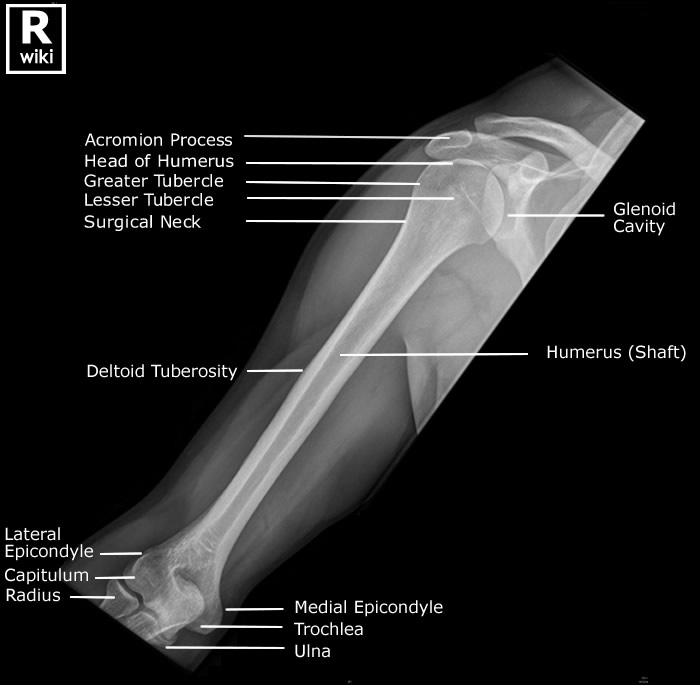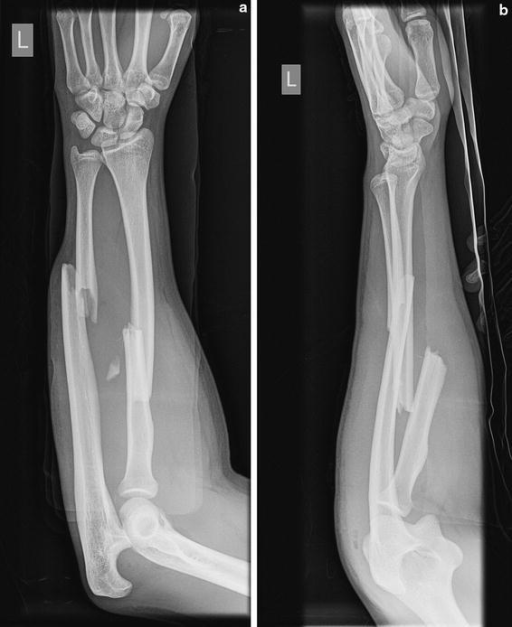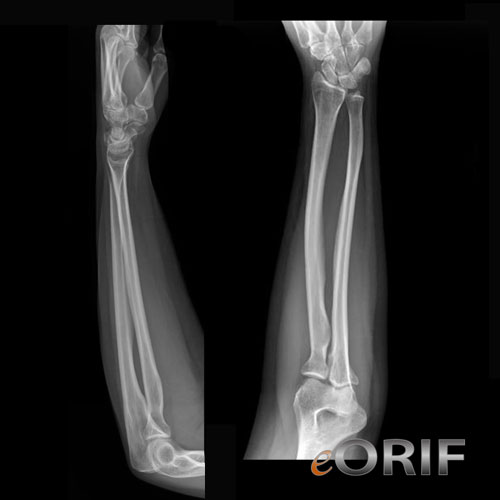
Image
This view demonstrates the elbow joint in its natural anatomical position allowing for assessment of suspected dislocations or fractures and localizing foreign bodies within the forearm. patient is seated alongside the table forearm is supinated, and its dorsal surface is kept in contact with the cassette with extension at the elbow joint

Some anatomy for the basic forearm radiographs! Kevin GrepMed
OBJECTIVE. The purpose of this article is to review the anatomy, biomechanics, and multimodality imaging findings of common and uncommon distal radioulnar joint (DRUJ), triangular fibrocartilage complex, and distal ulna abnormalities. CONCLUSION. The DRUJ is a common site for acute and chronic injuries and is frequently imaged to evaluate chronic wrist pain, forearm dysfunction, and traumatic.

Interpreting Elbow and Forearm Radiographs — Taming the SRU
fracture location (extra-, juxta- or intra-articular) degree of angulation degree of displacement carpus ensure no carpal malalignment or fractures are present assess articulation of radio-lunate and radio-scaphoid joint

Gudang Medis teknik radiografi antebrachii
Forearm x-rays are indicated for a variety of settings including: trauma bony tenderness suspected fracture obvious deformity non-traumatic pain suspected foreign body Projections Standard projections anteroposterior view demonstrates the radius and the ulna in the natural anatomical position lateral view projection 90° to the AP view

Humerus Radiographic Anatomy wikiRadiography
Anatomy . The brachialis muscle originates from the front of your humerus, or upper arm bone.It arises from the distal part of the bone, below your biceps brachii muscle. It then courses down the front of your arm, over your elbow joint, and inserts on the coronoid process and tuberosity of your ulna.The brachialis muscle, along with the supinator muscle, makes up the floor of the cubital.

Forearm Radiograph Radiology student, Medical radiography, Medical
Small Animal Elbow and Antebrachium Radiography Issue: July/August 2012 This is the sixth article in our Imaging Essentials series, which is focused on providing comprehensive information on radiography of different anatomic areas of dogs and cats. The following articles are available at todaysveterinarypractice.com:

Forearm X Ray Anatomy
Hand, humeral and antebrachii X-ray showed no fracture nor dislocation. Electromyography (EMG) test showed no nerve conduc- tion velocity of left axillary nerve injury. Patient underwent physio- therapy and given neuroprotectors. After 7 days, there was a significant improvement in shoulder abduction and left arm prona- tion.

forearm skeletal anatomy radiology
Presentation Fall from bike. Pain in wrist. Patient Data Age: 9 years Gender: Male x-ray Frontal Lateral Normal examination. No fracture. No joint effusion. Case Discussion Forearm x-rays are difficult. You end up with an frontal view of the wrist and a lateral view of the elbow on one image and the opposite on the other.

Antebrazo Xray mostrando una fractura de radio distal en un muchacho
X-rays are taken to ensure that the reduction was successful. The cast is usually maintained for about 6 weeks. X-ray in cast. Unsuccesful reduction. Guidelines for non-acceptable reduction are (8): Radial shortening > 5 mm; Radial inclination Tilt on lateral projection > 10 degrees dorsal tilt and > 20 degrees volar tilt;

a, b Preoperative anteroposterior and lateral radiograp Openi
The trauma dated of 1 day and X-ray was initially judged normal in the emergency department. Due to the persistence of the pain and the functional impotence, the patient presented again to our.

ANTEBRACHII FRACTURE PDF
Describe the common presentation of a patient with forearm fractures. Identify the various radiological investigations required for diagnosing forearm fractures. Explain the various treatment options for patients with forearm fractures, along with the complications anticipated. Access free multiple choice questions on this topic. Go to:

Gudang Medis teknik radiografi antebrachii
Overview. An X-ray is a quick, painless test that produces images of the structures inside your body — particularly your bones. X-ray beams pass through your body, and they are absorbed in different amounts depending on the density of the material they pass through. Dense materials, such as bone and metal, show up as white on X-rays.

X Ray Wrist Joint Post Trauma Radiology Imaging
Publicationdate 2005-08-23. This article is based on a presentation given by Louis Gilula and adapted for the Radiology Assistant by Ileana Chesaru. First a systematic analysis of the wrist is presented to look for carpal instability and fracture dislocation. Secondly cases are presented as examples in the chapter systematic review and diagnosis.

Forearm Xray eORIF
Both Bone Forearm Fractures are one of the most common pediatric fractures, estimated around 40% of all pediatric fractures. Diagnosis is made with plain radiographs of the forearm. Treatment is closed reduction and casting for the majority of fractures. Surgical intervention is indicated for significantly displaced or angulated fractures in.

Show Me A Picture Of A XRay imgultra
An observational study has been performed using US imaging to measure brachial and antebrachial fasciae thickness at anterior and posterior regions, respectively, of the arm and forearm at different levels with a new protocol in a sample of 25 healthy volunteers. Results of fascial thickness revealed statistically significant differences ( p.

Pin by Tracey Burns on Radiology Diagnostic imaging, Radiology
50-60 kVp 2-5 mAs SID 100 cm grid no Image technical evaluation the elbow is in an AP position, with slight internal rotation. patient's arm should be rotated externally to ensure that the trochlea and capitulum are seen in profile. Practical points At times, patients may not be able to fully extend their elbow joint.